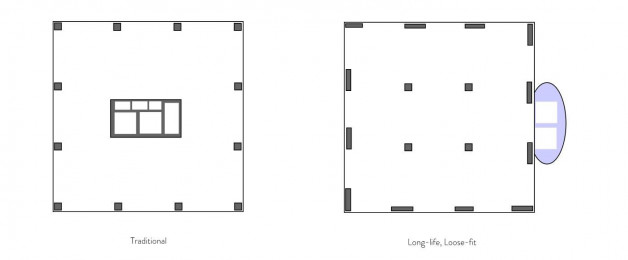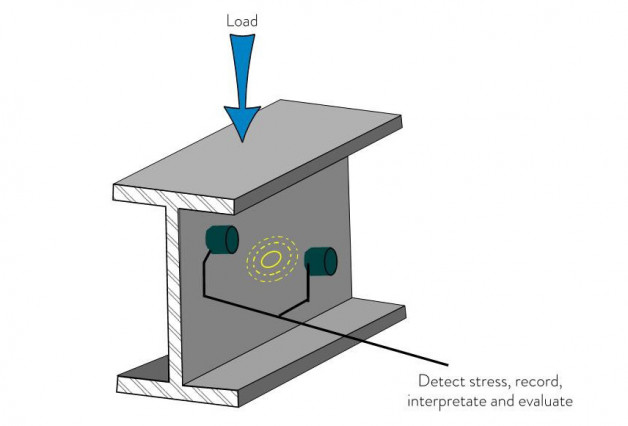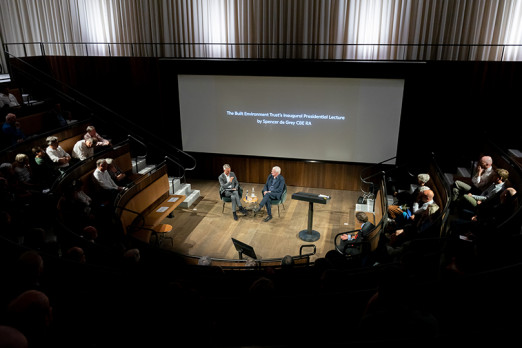Ed Moseley, Co-Founder and Director of London Structures Lab, writes about the increasing importance of minimising material usage and ways of achieving it.
The way we look at material use is changing. Minimising material use in construction needs to, and should, be of environmental, commercial and aesthetic benefit to projects.
Our seven steps to minimising material usage have been linked the RIBA project stages, highlighting the significance of early decisions, and to enable the progression from philosophical overview to practical application within projects.
The Status Quo
The MEICON report produced by Cambridge University includes some damning statistics for UK structural engineering consultants. Key findings of the report for the industry are:
- Average material usage of less than 50% of capacity (source Moynihan, M. and Allwood, J.)
- An average of 35-45% of the steel used in typical steel framed office buildings, by mass, is not required for structural efficiency
- Potential to reduce material usage in concrete structures by 30-40% through design optimisation.
- 63% of beams dominated by serviceability requirements rather than strength requirements
We all know the current pressure on natural resources and the impact that it is having on the planet. Many in the sector are already signatories of either Architects Declare or Engineers Declare. Why, with increasing levels of awareness, do shocking levels of inefficiency persist?
The MEICON survey did not identify a single leading factor but did show that the barriers to greater material efficiency are both cultural and technical. Both areas need to be addressed but whilst the technical can be seen as the domain of the engineer, cultural factors are due to industry wide norms that must be addressed collectively. The first question should always be “do we need a new building?” Can we improve our existing stock to provide greater utilisation, either through improved occupation levels or through building reinvention.
Assuming it has been determined a new building is required, here are our seven suggested steps for industry professionals to adopt to achieve long term reductions in material usage:
- Establish the right brief (RIBA Stage 0/1)
Light-weighting, long-life loose-fit or design for de-constructability? Debate about establishing the right design strategy for a building should be fundamental to the design process. Reconsidering permanence on a holistic, zonal and component basis is an integral part of any progressive design brief.
A lightweight design solution is considered to be the default design if the question of design life is not raised in the brief. Actively pursuing lean design is very different from continuing with the status quo, as can be seen from the assessment of the current construction norms. Looking at a holistic strategy, such as integrated structural and façade systems is essential to achieving minimum material usage. This often leads to a highly specific building, which potentially limits the life span of the structure but reduces the energy that goes into producing it to a minimum.
Long life-loose fit introduces adaptability into a structures design to ensure that it is capable of enabling changes of use. It has to acknowledge the buildings use, or elements of the building, will evolve over time. This might affect strategic thinking – for example, decoupling of the structural stability system from the service core, to anticipate that risers and lifts might change as MEP systems evolve.
A third and arguably the most important structural strategy in this context is to design for deconstructability, enabling materials to enter the circular economy- but the current barriers are significant. When it comes to the re-use of components that will be subject to the demolition process, it is challenging to provide suitable warrantees for material that may have lost its QA trail. What we should be doing is designing structure to be de-mountable and using BIM systems to track material in use, recording its certifications and enabling it to be used again to its full capacity. Designing buildings for de-mountability now and designing future buildings around component re-use is the most energy efficient and potentially cost effective strategy. Increasing the embodied energy of construction to give a capability for demounting that is never used would not be the right solution, and accepting that some areas of a building might not change is challenging to determine. It takes long term vision to implement this, not least because of the requirement to store and track materials to facilitate their reuse.
At the outset of a project a discussion on the building's design life and strategy should be held. It unlocks conversations about varying levels of durability between components of the build, potentially allowing for the renewal of façade and cores, whilst retaining the majority of the primary structure.
This process of assessment should reduce both immediate and whole life costs for the development.
- Challenge design parameters (RIBA Stage 2)
Structural loadings for many buildings are defined prior to the design for the interior being completed. It is widely appreciated by many engineers that most buildings are unlikely to ever realise the full design loadings, but design loadings reflect a solution that “works” providing flexibility in the selection of fit out choice and building use. Serviceability limits for design generally relate to movement. Movement limitations are primarily governed by follow on trades, such as the header details for fire stopping, or the sensitivity of the façade system. Their influence on the quantum of materials in a structure is significant and their necessity is not always clear at the initial stages of a project.
When developing design options, it should be clear what overall brief is being followed, what design parameters are being used and how they relate to follow on trades should all be clearly stated. Coupling this information with carbon trackers (discussed further in item 6 below) enables informed decisions to be made by the collective team.
- Adjust the attitude to risk (RIBA Stage 2)
Design to 100% utilisation. One of the key factors quoted in the MEICON survey as reason for engineers designing to 80% of capacity as opposed to 100% was design uncertainty. This isn’t an issue that can be solely being addressed by structural engineers, the design process can ensure that once clarity is achieved on structural performance parameters the project enables the design to be revisited.
As an industry we want finite answers. At the early stages of design, what could be offered is a range of structural sizes depending on how the design develops, ultimately this should give opportunity for an optimised design.
- Embrace technological progression (RIBA Stage 3)
Once the design is clarified, and fundamental decisions such as building geometry, occupational organisation, principle materials and structural principles are confirmed a greater level of detail can be studied.
Technical innovation in fabrication is developing, as is the link between analysis and fabrication. How can future designs be informed by the manufacturing advances? Automation of the fabrication process should enable more specific links between the performance parameters defined by the analysis and the material usage in production. Profiled beams and slabs have to date been the province of academic research and one-off structures. Wide scale implementation needs to address the industry drivers of standardisation. Whilst standardisation is a less efficient use of materials it is not a flippant choice, it enables faster production and construction programs and simplification of interaction with other aspects of the building.
- Analyse real building performance (RIBA Stage 3/4)
As most buildings have at least some bespoke aspects to their design there are factors influencing structural behaviour which frequently go unaccounted for or concealed within a design envelope of potential behaviours. Structural analysis is frequently element based, but real behaviour assessment requires system based assessments, where adjacent elements are included in the analysis so the interaction between them can be assessed.
Engineers can produce a map of the real load capacity of their floors. It is standard practice to include design loadings in an operations manual for the building. Including real capacity would facilitate future developments in how the building is occupied, or how it is redeveloped/ reinvented.
- Measure and re-assess (RIBA Stage 4)
The basic tools to assess carbon content are available from the Environmental Agency and facilitate the early assessment of options studies against carbon usage. You can download it here.
As the specifications for the contract are being written significant steps can be made to ensure that lower energy products are being used.
- Monitor buildings in use (RIBA Stage 7)
Post occupancy monitoring is seldom performed in structural engineering but is essential in the ratification of any significant overhaul of the design guidance. This feedback loop enables the progression of design guidance to reflect changing occupancy habits and progression in specification and analysis.
With this step, as with most of the actions outlined above, the sharing of data is key to making any significant advancements. Moving towards a data driven approach to design requires data. It sounds simple, but this is one of the key stumbling blocks preventing structural engineering being the progressive discipline it should be.
Recommended further reading:
http://www.wrap.org.uk/sites/files/wrap/FINAL%20PRO095-009%20Embodied%20Carbon%20Annex.pdf







.jpg)

